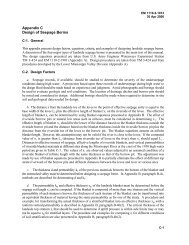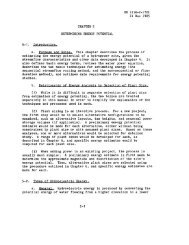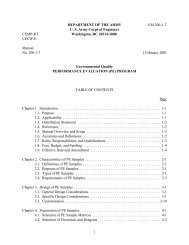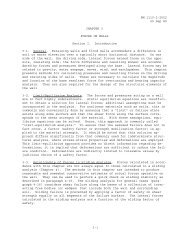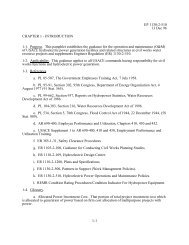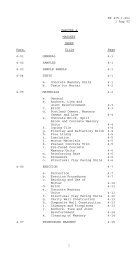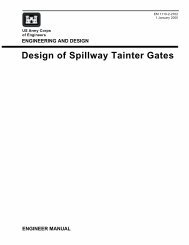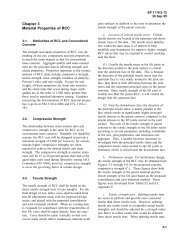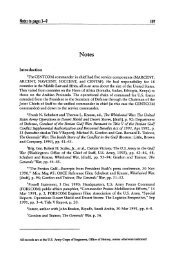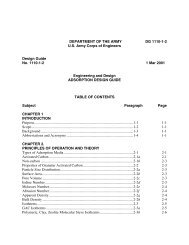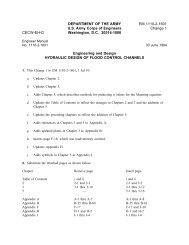Earthquake Design and Evaluation of Concrete Hydraulic Structures
Earthquake Design and Evaluation of Concrete Hydraulic Structures
Earthquake Design and Evaluation of Concrete Hydraulic Structures
You also want an ePaper? Increase the reach of your titles
YUMPU automatically turns print PDFs into web optimized ePapers that Google loves.
EM 1110-2-6053<br />
1 May 2007<br />
Load Case 2:<br />
Q = Q + Q ± α Q ± Q<br />
(3-2)<br />
DC<br />
D<br />
L<br />
MDE(<br />
X1)<br />
MDE(<br />
X 2)<br />
Generally α is assumed to be 0.30 for rectangular structures, <strong>and</strong> 0.40 for circular structures.<br />
QDC = peak value <strong>of</strong> any response quantity (forces, shears, moments, stresses, or<br />
displacements) due to the effects <strong>of</strong> dead load, live load, <strong>and</strong> the MDE<br />
QMDE(X1) = effects resulting from the X1 component <strong>of</strong> the MDE ground motion occurring in<br />
the direction <strong>of</strong> the 1 st principal axis <strong>of</strong> the structure.<br />
QMDE(X2) = effects resulting from the X2 component <strong>of</strong> the MDE ground motion occurring in<br />
the direction <strong>of</strong> the 2 nd principal axis <strong>of</strong> the structure.<br />
c. Square Root <strong>of</strong> the Sum <strong>of</strong> the Squares Method (SRSS). A better way to combine<br />
structural responses for the multi-component earthquake response spectra is the use <strong>of</strong> the<br />
SRSS method. This method is applicable to rectangular <strong>and</strong> complex three-dimensional<br />
structures. For any response quantity <strong>of</strong> interest, e.g. moment or shear at a particular location,<br />
the results from the separate application <strong>of</strong> each component <strong>of</strong> ground motion are combined by<br />
the square root <strong>of</strong> the sum <strong>of</strong> the squares to obtain the total response. Note that since<br />
response-spectrum stresses, forces, or moments have no sign, the combination should consider<br />
response-spectrum quantities to be either positive or negative. Illustrating for the MDE loading<br />
combination, Equation 2-1, the SRSS dem<strong>and</strong> would be as follows:<br />
DC<br />
D<br />
L<br />
[ ] 2 / 1<br />
2<br />
2<br />
2<br />
Q ) + ( Q ) ( Q )<br />
Q = Q + Q ±<br />
+<br />
(3-3)<br />
( MDE ( X 1)<br />
MDE ( X 2)<br />
MDE ( Z )<br />
d. Critical Direction <strong>of</strong> Ground Motion. The directions <strong>of</strong> ground motion incidence are<br />
usually assumed along the fixed structural reference axes. Considering that the ground motion<br />
can act along any horizontal direction, there could be a different direction <strong>of</strong> seismic incidence<br />
that would lead to an increase <strong>of</strong> structural dynamic response. The maximum structural<br />
response associated to the most critical directions <strong>of</strong> ground motions has been examined in<br />
several publications (Wilson <strong>and</strong> Button 1982, Smedy <strong>and</strong> Der Kiureghian 1985, Wilson et al.<br />
1995, Lopes <strong>and</strong> Torres 1997, <strong>and</strong> Lopez et al. 2000). These investigations indicate that the<br />
critical direction <strong>of</strong> the horizontal ground motion components yielding the maximum structural<br />
response depends on the two horizontal spectra <strong>and</strong> also on the structural response parameters<br />
but not on the vertical spectrum. For the special case <strong>of</strong> identical spectra along the two<br />
horizontal directions, the structural response does not vary with the angle <strong>of</strong> incidence, i.e. any<br />
direction is a critical direction. The response value for this special case is the upper bound to all<br />
possible structural responses due to any combination <strong>of</strong> spectral ratios <strong>and</strong> angle <strong>of</strong> incidence.<br />
A conservative approach is therefore to analyze the structure with the same horizontal spectrum<br />
applied simultaneously along the two horizontal structural reference directions, <strong>and</strong> the vertical<br />
spectrum.<br />
e. Load combination cases for time history analysis. 3D time-history analysis <strong>of</strong> CHS with<br />
response in the damage control range should be evaluated for three or more sets <strong>of</strong> threecomponent<br />
earthquake ground motions plus the effects <strong>of</strong> usual static loads. For each set <strong>of</strong><br />
three-component earthquake ground motions the static loads <strong>and</strong> earthquake ground motion<br />
components should be combined in accordance with Table 3-1. In general, a complete<br />
3-4




